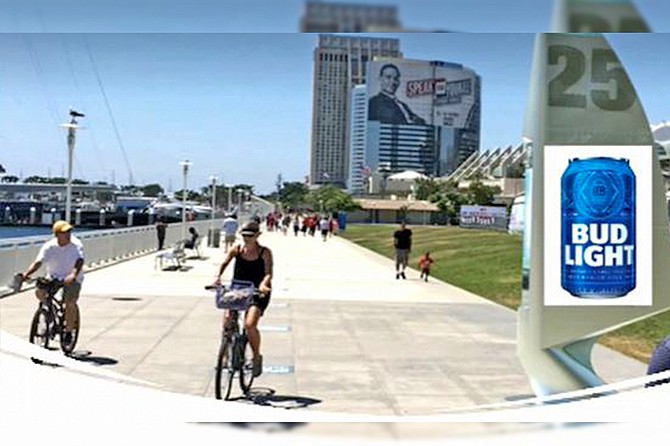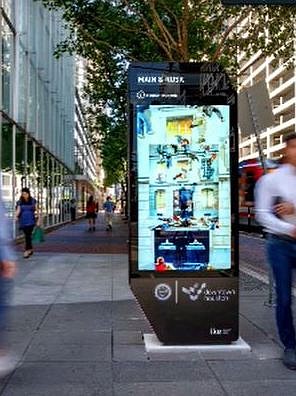 Facebook
Facebook
 X
X
 Instagram
Instagram
 TikTok
TikTok
 Youtube
Youtube

They're a step closer to landing on a sidewalk downtown, but not an inch closer to universal love: dozens of eight-foot-tall digital kiosks that threaten to end the city's historic ban on new outdoor advertising.
The Planning Commission last week voted 4-2 to recommend the San Diego City Council amend its sign ordinance to allow for at least 50 digital advertising and wayfinding kiosks downtown - a project the city calls a "pilot."
It's similar to a plan the port rejected in 2018, and some say San Diego, a pioneer in warding off once-static billboards, has become a target of visual advertisers.
"We're sort of a pristine little gem here. You don't see this kind of thing, you don't see more billboards. There are no digital billboards," said Pamela Wilson, the founder of Scenic San Diego, urging the commission to vote no.
The city attorney's office has repeatedly warned that allowing exceptions to the offsite advertising ban, as the proposal does, could undermine the legal defensibility of the sign regulations.
"How is this different from just blowing up the sign ordinance and putting advertising around our city?" Wilson asked.

In 1981, the city's effort to thwart the spread of unsightly signage ended when the Supreme Court determined that cities have the right to limit them for aesthetics and traffic safety. There hasn't been a single one added since 1983.
But downtown has grown. Over the years it's gotten easier to get lost, and there's more to find. Seeking wayfinding solutions, the city in 2021 sought a partner it could provide with marketing benefits in exchange for a digital wayfinding system in the civic core, Columbia, Marina, Horton Plaza and Gaslamp Quarter, East Village, Cortez, and the Convention Center district.
Two proposals came in, but only IKE Smart City, LLC was willing to make accessibility changes to their design. A 10-year marketing agreement between the city, Downtown San Diego Partnership, and IKE is proposed to create a digital wayfinding system in the civic core, Columbia, Marina, Horton Plaza and Gaslamp Quarter, East Village, Cortez, and the Convention Center district.
The agreement does not preclude the city from receiving other partnerships related to wayfinding.
The ADA-compliant kiosks would have a 65-inch interactive digital display that either shows eight advertising content slots with 10-second intervals (when not in use) or allows touch-based interaction.
The city said the kiosks can provide the public storm warnings, emergency updates, information on homeless services, and bus schedules. A call button will state that it goes to Downtown San Diego Partnership's clean and safe line - not a standard emergency line.
Betsy Brennan, president of the non-profit business association, said the downtown clean and safe partnership has "for at least the last five years been able to answer that telephone 24 hours, 365 days a year."
The dispatch line already receives more than 4,000 calls just for directional assistance, she said. If there's a couch in the middle of 4th Avenue, they will dispatch a truck. If it's an escort needed from a business at 9 pm, a safety ambassador can walk the person from that kiosk to wherever they need to go.
"We wanted to have a lower barrier here in San Diego than they have in the other 15 cities where they have kiosks, which is 911."
The city said the kiosks will help people find everything from restaurants and conventions to Uber rides and the location of scooters.
While they can't show the active Uber or Lyft cars, an Ike spokesman said users can plan a multi-modal trip; say a scooter from one location, followed by Uber.
There will be no strobes or flashing lights and the system will be subject to the same advertising guidelines as the city's bus bench and shelter program. "Nothing lewd, and no drugs, alcohol or firearms."
Software will be updated monthly, and the computing components every few years.
Supporters say the kiosks would generate an estimated $14.7 million in ad revenue over 10 years, money that will go to the city and Downtown San Diego Partnership, and to IKE.
Brennan, who leads the Downtown San Diego Partnership, said the money "will definitely be spent downtown and it will be a community process to figure out where those dollars are spent."
There will be community surveys and meetings, she said, to decide if the revenue should be provided to the unsheltered or for things like street cleaning, flower baskets and placemaking.
Ronald Askland, chair of San Diego Sierra Club Conservation Committee, said the group strongly opposes the plan to "bring intrusive digital advertising to the center of the city."
The revenue would be limited, the garish ads a safety hazard, and the talk of improved mobility "a farce," he said.
"I'd really like to challenge this transit information and mobility. So let's say I walk up to this massive kiosk and I want to go to a cafe and it says walk three blocks here, two blocks here, take the trolley. I get off, walk f our more blocks - I'm gonna memorize that? You're gonna use your cell phone. It's a joke."
The public service content on kiosks could be better viewed on smartphones using a city-sponsored website, he said,
Commission chair Bill Hofman, who along with commissioner Dennis Otsuji voted against the proposal, agreed.
"I just don't see the need," he said. "I believe this will not be a substitute for cell phones. Cell phones are far more convenient; you don't have to walk two blocks to look at them and a cell phone can do everything that these kiosks will do."
The proposal is expected to go to the full city council for a vote in May.


They're a step closer to landing on a sidewalk downtown, but not an inch closer to universal love: dozens of eight-foot-tall digital kiosks that threaten to end the city's historic ban on new outdoor advertising.
The Planning Commission last week voted 4-2 to recommend the San Diego City Council amend its sign ordinance to allow for at least 50 digital advertising and wayfinding kiosks downtown - a project the city calls a "pilot."
It's similar to a plan the port rejected in 2018, and some say San Diego, a pioneer in warding off once-static billboards, has become a target of visual advertisers.
"We're sort of a pristine little gem here. You don't see this kind of thing, you don't see more billboards. There are no digital billboards," said Pamela Wilson, the founder of Scenic San Diego, urging the commission to vote no.
The city attorney's office has repeatedly warned that allowing exceptions to the offsite advertising ban, as the proposal does, could undermine the legal defensibility of the sign regulations.
"How is this different from just blowing up the sign ordinance and putting advertising around our city?" Wilson asked.

In 1981, the city's effort to thwart the spread of unsightly signage ended when the Supreme Court determined that cities have the right to limit them for aesthetics and traffic safety. There hasn't been a single one added since 1983.
But downtown has grown. Over the years it's gotten easier to get lost, and there's more to find. Seeking wayfinding solutions, the city in 2021 sought a partner it could provide with marketing benefits in exchange for a digital wayfinding system in the civic core, Columbia, Marina, Horton Plaza and Gaslamp Quarter, East Village, Cortez, and the Convention Center district.
Two proposals came in, but only IKE Smart City, LLC was willing to make accessibility changes to their design. A 10-year marketing agreement between the city, Downtown San Diego Partnership, and IKE is proposed to create a digital wayfinding system in the civic core, Columbia, Marina, Horton Plaza and Gaslamp Quarter, East Village, Cortez, and the Convention Center district.
The agreement does not preclude the city from receiving other partnerships related to wayfinding.
The ADA-compliant kiosks would have a 65-inch interactive digital display that either shows eight advertising content slots with 10-second intervals (when not in use) or allows touch-based interaction.
The city said the kiosks can provide the public storm warnings, emergency updates, information on homeless services, and bus schedules. A call button will state that it goes to Downtown San Diego Partnership's clean and safe line - not a standard emergency line.
Betsy Brennan, president of the non-profit business association, said the downtown clean and safe partnership has "for at least the last five years been able to answer that telephone 24 hours, 365 days a year."
The dispatch line already receives more than 4,000 calls just for directional assistance, she said. If there's a couch in the middle of 4th Avenue, they will dispatch a truck. If it's an escort needed from a business at 9 pm, a safety ambassador can walk the person from that kiosk to wherever they need to go.
"We wanted to have a lower barrier here in San Diego than they have in the other 15 cities where they have kiosks, which is 911."
The city said the kiosks will help people find everything from restaurants and conventions to Uber rides and the location of scooters.
While they can't show the active Uber or Lyft cars, an Ike spokesman said users can plan a multi-modal trip; say a scooter from one location, followed by Uber.
There will be no strobes or flashing lights and the system will be subject to the same advertising guidelines as the city's bus bench and shelter program. "Nothing lewd, and no drugs, alcohol or firearms."
Software will be updated monthly, and the computing components every few years.
Supporters say the kiosks would generate an estimated $14.7 million in ad revenue over 10 years, money that will go to the city and Downtown San Diego Partnership, and to IKE.
Brennan, who leads the Downtown San Diego Partnership, said the money "will definitely be spent downtown and it will be a community process to figure out where those dollars are spent."
There will be community surveys and meetings, she said, to decide if the revenue should be provided to the unsheltered or for things like street cleaning, flower baskets and placemaking.
Ronald Askland, chair of San Diego Sierra Club Conservation Committee, said the group strongly opposes the plan to "bring intrusive digital advertising to the center of the city."
The revenue would be limited, the garish ads a safety hazard, and the talk of improved mobility "a farce," he said.
"I'd really like to challenge this transit information and mobility. So let's say I walk up to this massive kiosk and I want to go to a cafe and it says walk three blocks here, two blocks here, take the trolley. I get off, walk f our more blocks - I'm gonna memorize that? You're gonna use your cell phone. It's a joke."
The public service content on kiosks could be better viewed on smartphones using a city-sponsored website, he said,
Commission chair Bill Hofman, who along with commissioner Dennis Otsuji voted against the proposal, agreed.
"I just don't see the need," he said. "I believe this will not be a substitute for cell phones. Cell phones are far more convenient; you don't have to walk two blocks to look at them and a cell phone can do everything that these kiosks will do."
The proposal is expected to go to the full city council for a vote in May.
Comments